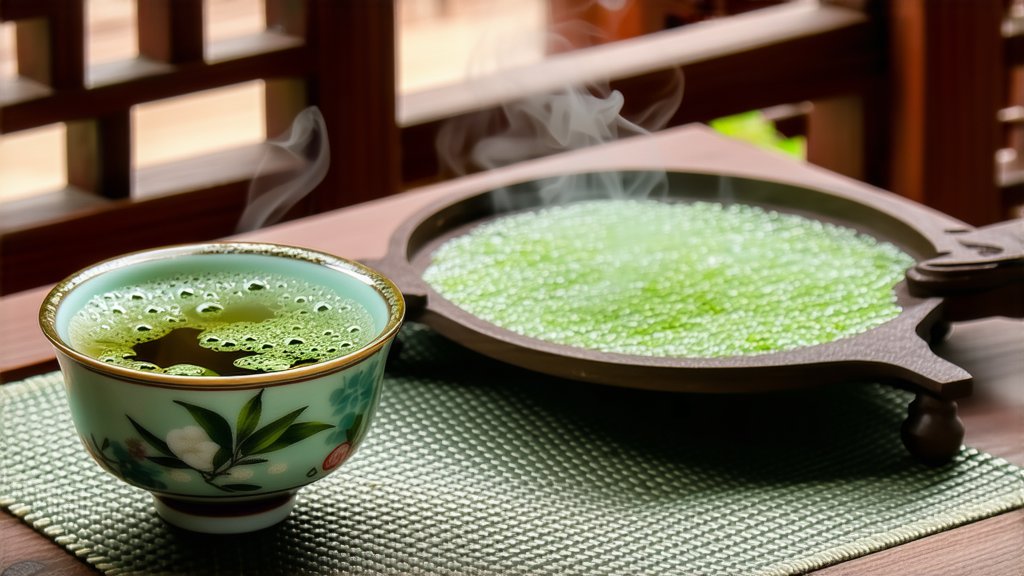
Longjing tea, often referred to as "Dragon Well" tea, is one of the most revered varieties of Chinese green tea. Its name translates to "Dragon Well," which is derived from the famous West Lake in Hangzhou, Zhejiang Province, where this exquisite tea has been cultivated for centuries. This article delves into the rich history, diverse types, intricate production process, and nuanced methods of appreciating Longjing tea, offering international readers an immersive journey into the heart of Chinese tea culture.
Historical Background
The origins of Longjing tea date back to the Tang Dynasty (618-907 AD), but it gained prominence during the Qing Dynasty when Emperor Kangxi proclaimed it as the "Imperial Tea." According to legend, two dragons once visited West Lake and breathed life into a well, creating a spring that nourished the surrounding tea plants. These mythical creatures were said to have left their mark on the tea leaves, giving them their unique characteristics. Over time, Longjing tea became synonymous with quality and elegance, becoming a symbol of Chinese tea culture.
Varieties of Longjing Tea
Longjing tea comes in several distinct grades, each with its own unique flavor profile and appearance. The highest quality grade is known as "Xi Hu Long Jing," meaning "West Lake Dragon Well," which refers to tea grown in the original West Lake region. Other notable varieties include "Qian Tang Long Jing," "Yue Fei Long Jing," and "Jingshan Long Jing." Each variety showcases the terroir of its specific growing region, contributing to a diverse range of flavors and aromas within the broader category of Longjing tea.
Production Process
The meticulous craftsmanship behind Longjing tea is what sets it apart from other green teas. The production process involves several stages:
-
Hand-picking: Only the tenderest young leaves and buds are selected, typically in early spring when they contain the highest concentration of nutrients and flavor compounds.
-
Withering: Freshly picked leaves are spread out thinly to allow moisture content to decrease gradually, softening the leaves for subsequent steps.
-
Fixation: This crucial step halts enzyme activity by quickly heating the leaves in a large wok or pan over high heat. The skilled tea master must constantly toss the leaves to ensure even heating without scorching them.
-
Shaping: After fixation, the leaves are shaped through a series of rolling and pressing techniques to achieve their distinctive flat shape. This process requires great dexterity and precision.
-
Drying: The shaped leaves are then dried slowly to remove any remaining moisture, ensuring stability and longevity.
-
Sorting and Packaging: Finally, the dried leaves are sorted by size and quality before being carefully packaged to preserve freshness.
Appreciating Longjing Tea
To fully appreciate the subtleties of Longjing tea, one must engage in a traditional Chinese tea ceremony. Here's a step-by-step guide to experiencing this ancient practice:
-
Preparation: Use a clean porcelain or glass teapot and cups to avoid contamination of flavors. Boil water to around 80°C (176°F) to prevent scalding the delicate leaves.
-
Warming the Teaware: Rinse the teapot and cups with hot water to warm them up, discarding the initial wash water immediately afterward.
-
Infusion: Place approximately 3 grams of loose leaf tea per 150ml of water ratio into the teapot. Steep for about 1-2 minutes for the first infusion. Subsequent infusions can be steeped for slightly longer periods.
-
Aroma: Before taking your first sip, inhale deeply to savor the fragrant aroma released by the steaming tea. Note its complexity and depth.
-
Tasting: Sip slowly, allowing the liquid to coat your entire palate. Pay attention to the balance between sweetness, bitterness, astringency, and umami flavors. Notice how these elements evolve throughout multiple infusions.
-
Observation: Admire the beautiful color of the brewed tea—a clear, light green hue indicative of high-quality Longjing. Observe the graceful unfurling of leaves as they rehydrate in the water.
Conclusion
Longjing tea represents not just a beverage but an art form steeped in history and tradition. From its legendary origins to its meticulous production process and refined tasting rituals, every aspect of this green tea embodies the essence of Chinese culture. Whether enjoyed alone or shared among friends, Longjing tea offers a window into a world where nature, artistry, and philosophy converge harmoniously. For those seeking a deeper connection with both themselves and the natural world, exploring the enchanting realm of Longjing tea is an invitation worth accepting.